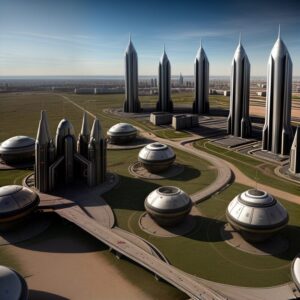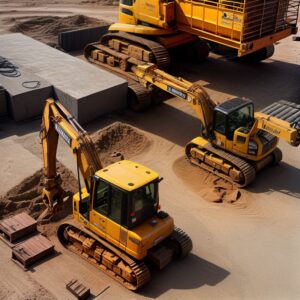 The Dream of Mars Colonization
The Dream of Mars Colonization
For decades, humanity has been captivated by the prospect of colonizing Mars. This fascination stems from a blend of scientific curiosity, the pursuit of knowledge, and the innate human drive to explore new frontiers. Mars, often referred to as the Red Planet, offers a unique combination of factors that make it a compelling candidate for a potential second home for humanity.
Mars shares several similarities with Earth that make it an attractive option for colonization. Its day length, or sol, is just over 24 hours, closely mirroring that of Earth. Additionally, Mars has polar ice caps, seasonal weather patterns, and a diverse terrain that includes mountains, valleys, and plains, all reminiscent of Earth’s own landscapes. These characteristics provide a sense of familiarity and the potential for human adaptation.
The scientific community is particularly intrigued by Mars due to its potential to answer fundamental questions about the origins of life. Evidence suggests that Mars once had liquid water on its surface, raising the possibility that it may have harbored life in the past. By exploring Mars, scientists hope to gain insights into the planet’s geological history and uncover clues about the conditions necessary for life to exist.
However, the journey to Mars is fraught with challenges. The vast distance between Earth and Mars poses significant hurdles in terms of space travel technology, life support systems, and the psychological effects of long-duration missions. The harsh environment of Mars, with its thin atmosphere, extreme temperatures, and high radiation levels, further complicates the prospect of human survival.
To address these challenges, innovative solutions are essential. Advances in robotics, artificial intelligence, and material science are crucial for developing the infrastructure needed to sustain human life on Mars. In particular, humanoid robots are expected to play a vital role in the construction and maintenance of Martian habitats, enabling humans to focus on exploration and scientific research.
 The Challenges of Building Cities on Mars
The Challenges of Building Cities on Mars
Constructing cities on Mars presents a myriad of challenges, primarily due to the planet’s harsh environmental conditions. One of the most significant obstacles is the extreme temperature fluctuations. Mars experiences drastic changes in temperature, with daytime highs reaching around 20 degrees Celsius and nighttime lows plummeting to -73 degrees Celsius. These severe variations necessitate the development of robust and adaptable building materials that can withstand such extremes.
Another critical challenge is radiation exposure. Unlike Earth, Mars lacks a protective magnetic field and a dense atmosphere, which results in higher levels of cosmic and solar radiation reaching the surface. This poses a substantial risk to both human health and electronic equipment. Solutions must be found to shield inhabitants and sensitive technology from this constant bombardment. Innovations in radiation-resistant materials and underground habitats might be crucial in mitigating this issue.
Dust storms on Mars are another notable concern. These storms can engulf the entire planet and last for weeks, significantly reducing visibility and disrupting solar power generation. The abrasive nature of Martian dust can damage machinery and infrastructure, posing additional challenges for maintenance and repair. Developing dust-resistant technologies and efficient cleaning systems will be essential for ensuring the longevity and functionality of Martian cities.
Logistical issues also play a significant role in the complexity of Mars City construction. Transporting materials from Earth to Mars is both costly and time-consuming, necessitating the development of in-situ resource utilization (ISRU) techniques. These techniques involve using local materials, such as regolith, to produce building components, thereby reducing dependency on Earth-based supplies. Ensuring a sustainable supply of resources, such as water, oxygen, and food, is also vital for the long-term survival of human settlers.
Maintaining human health and safety in such a hostile environment requires comprehensive planning and innovative solutions. Life support systems must be capable of providing clean air, potable water, and nutritious food while managing waste. Medical facilities need to be equipped to handle emergencies and routine health care. Psychological well-being is equally important, as isolation and confinement can lead to mental health issues among residents.
The Role of Humanoid Robots in Overcoming Construction Challenges
The construction of cities on Mars presents a unique set of challenges that demand innovative solutions. One of the most promising strategies involves the deployment of humanoid robots. These advanced machines offer several advantages in addressing the difficulties of Martian construction. Firstly, humanoid robots are designed to withstand the harsh conditions of the Martian environment, including extreme temperatures, radiation, and dust storms. Their robust construction allows them to operate efficiently where human presence would be fraught with danger.
Moreover, humanoid robots excel in performing repetitive and labor-intensive tasks with precision and consistency. Tasks such as assembling structures, transporting materials, and executing intricate construction procedures can be carried out tirelessly by these robots, ensuring a higher degree of accuracy and efficiency compared to human workers. This capability is crucial in an environment where any error could have catastrophic consequences due to the remoteness and inaccessibility of Mars.
In addition to enhancing efficiency, the use of humanoid robots significantly reduces the risk to human workers. Martian construction sites pose numerous hazards, from unstable surfaces to unknown environmental threats. By delegating high-risk tasks to robots, we can minimize the potential for human injury or fatality, thereby making the overall construction process safer.
Technological advancements in robotics have been instrumental in making these machines suitable for Martian construction. Innovations in artificial intelligence, sensor technology, and materials science have led to the development of robots that can adapt to complex and dynamic environments. For instance, modern humanoid robots are equipped with advanced AI algorithms that enable them to learn from their surroundings and make autonomous decisions, ensuring they can handle unforeseen challenges effectively.
Furthermore, the integration of advanced sensor systems allows these robots to navigate and interact with their environment with a high degree of accuracy. These sensors can detect changes in terrain, identify potential obstacles, and facilitate precise movements, all of which are essential for successful construction on Mars.
In conclusion, the role of humanoid robots in overcoming the challenges of Mars construction is pivotal. Their ability to operate under harsh conditions, perform repetitive tasks efficiently, and reduce the risk to human workers, coupled with continuous technological advancements, positions them as integral components in the future of Martian city construction.
Technological Innovations in Humanoid Robots
The advent of humanoid robots has revolutionized numerous industries, with technological advancements pushing the boundaries of what these machines can achieve. At the forefront of these innovations are artificial intelligence (AI) and machine learning, which have significantly enhanced the functionality and adaptability of humanoid robots. AI enables robots to process vast amounts of data and make real-time decisions, while machine learning allows them to learn from their experiences and improve their performance over time.
Another critical innovation lies in the development of advanced materials. These materials not only improve the durability of humanoid robots but also enable them to operate in harsh environments, such as the Martian surface. Lightweight yet robust materials like carbon fiber composites and titanium alloys are commonly used to construct the exoskeletons of these robots, ensuring they can withstand extreme temperatures and abrasive dust storms.
Several case studies illustrate the capabilities of current humanoid robots. NASA’s Valkyrie, for instance, is a prime example of a humanoid robot designed for space exploration. Valkyrie is equipped with a range of sensors and cameras, allowing it to navigate and perform tasks autonomously in challenging environments. Similarly, the European Space Agency’s (ESA) Robonaut has been tested in simulated Mars-like conditions, demonstrating its proficiency in performing complex tasks such as repairing equipment and conducting scientific experiments.
These advancements are not just theoretical; they have practical implications for the future of living on Mars. Humanoid robots equipped with AI, machine learning, and advanced materials will play a crucial role in constructing and maintaining Martian cities. By leveraging these technological innovations, we can ensure that humanoid robots are well-prepared to tackle the challenges of building a sustainable human presence on the Red Planet.
 The Construction Process: From Blueprint to Reality
The Construction Process: From Blueprint to Reality
The construction of cities on Mars is a complex, multi-faceted endeavor that requires meticulous planning and execution. The process begins with the creation of detailed blueprints, crafted by a collaborative team of engineers, architects, and scientists. These blueprints serve as the foundational roadmap, outlining every aspect of the city’s infrastructure, from residential zones to energy and resource management systems.
Once the blueprints are finalized, the construction phase commences, heavily relying on the capabilities of humanoid robots. These robots are programmed to perform a myriad of tasks, from surveying the Martian terrain to assembling intricate structures. Their precision and resilience are crucial in an environment where human labor is limited and conditions are harsh.
One of the pivotal technologies in Martian construction is 3D printing. This innovative method allows for the creation of building components directly on-site, using materials sourced from the Martian surface. By utilizing regolith, the loose soil, and rock covering Mars, 3D printers can fabricate durable, sustainable structures. This not only reduces the need for transporting materials from Earth but also accelerates the construction timeline significantly.
Modular construction techniques also play a vital role in building Martian cities. Prefabricated modules, produced either on Earth or on Mars, are designed to interlock seamlessly, enabling rapid assembly and scalability. These modules can serve various purposes, including living quarters, laboratories, and communal spaces, and their modular nature allows for easy expansion of the city as the population grows.
The collaboration between human engineers and humanoid robots is imperative throughout the construction process. While robots handle the bulk of the physical labor, human oversight ensures that the construction adheres to the design specifications and safety standards. Engineers remotely monitor the robots, providing guidance and making real-time adjustments as needed.
In conclusion, constructing cities on Mars is a synergistic effort that combines advanced robotics, innovative technologies like 3D printing, and modular construction techniques. This integrated approach not only makes the ambitious goal of Martian colonization feasible but also sets the stage for sustainable, efficient development on the Red Planet.
Sustainability and Self-Sufficiency on Mars
As humanity ventures into establishing cities on Mars, the sustainability and self-sufficiency of these habitats become paramount. The harsh Martian environment demands innovative solutions to ensure long-term survival and operational efficiency. One of the key components in achieving this goal is the deployment of humanoid robots, which can significantly contribute to the development and maintenance of life support systems, water and energy generation, and food production.
Life support systems on Mars must be meticulously designed to provide breathable air, potable water, and appropriate living conditions. Humanoid robots, with their advanced dexterity and adaptability, can play a crucial role in assembling and maintaining these systems. They can perform complex tasks such as repairing air filtration units, monitoring atmospheric conditions, and ensuring that all systems function optimally to sustain human life.
Water generation on Mars poses a significant challenge due to the scarcity of liquid water. Robots can be instrumental in extracting water from the Martian soil through processes like electrolysis, which separates water molecules from the soil’s hydrated minerals. These robots can also manage the recycling of wastewater, ensuring that every drop is reused efficiently, thus creating a closed-loop water system essential for self-sufficiency.
Energy generation is another critical aspect of Martian sustainability. Solar power is the most viable energy source on Mars, and humanoid robots can assist in the installation and maintenance of solar panels. Their ability to perform routine inspections and repairs ensures that the energy systems operate at maximum efficiency, providing a reliable power supply for the Martian cities.
Food production on Mars will rely heavily on hydroponic and aeroponic systems, which can be labor-intensive to set up and maintain. Humanoid robots can manage these agricultural systems, from planting and harvesting crops to monitoring nutrient solutions and environmental conditions. Their involvement ensures a steady food supply, reducing the dependency on Earth for sustenance.
Maintaining and repairing the infrastructure of Martian cities is another area where humanoid robots will be indispensable. The harsh environmental conditions can cause wear and tear on habitats, energy systems, and life support units. Robots can perform regular maintenance checks, identify issues before they become critical, and carry out repairs, ensuring the continuous operation of the city.
In conclusion, the role of humanoid robots in creating self-sufficient Martian cities cannot be overstated. Their ability to perform complex tasks across various domains is crucial for the sustainability and long-term viability of human settlements on Mars.
Ethical and Societal Implications
The deployment of humanoid robots for the construction of cities on Mars raises significant ethical and societal questions. One primary concern is the potential impact on human jobs. While humanoid robots can perform laborious and hazardous tasks more efficiently, there is a risk that they may displace human workers, leading to job scarcity. This scenario necessitates a reevaluation of workforce roles and the development of new skills to manage and operate these advanced robots, ensuring that humans remain integral to the process.
Another critical aspect is the ethical treatment of robots themselves. As humanoid robots become more sophisticated and autonomous, questions about their rights and ethical treatment emerge. Should these robots be granted certain rights, and if so, to what extent? Establishing ethical guidelines for the treatment of robots is essential to prevent potential abuses and ensure that their deployment aligns with human values and societal norms.
Moreover, the creation of a society that relies heavily on robotic labor has broader implications. It could lead to profound cultural shifts, altering the way humans perceive work, productivity, and even their sense of purpose. The psychological effects of living alongside robots in an extraterrestrial environment also warrant consideration. Humans may experience a range of emotions, from comfort and security to feelings of isolation or insignificance, as robots perform tasks that were traditionally the domain of humans.
These changes could reshape the social fabric of Martian colonies, influencing everything from community dynamics to individual mental health. It is crucial to anticipate and address these potential impacts through proactive policies and support systems. By fostering an environment where humans and robots can coexist harmoniously, we can create a sustainable and ethically sound future for life on Mars.
The Future of Human-Robot Collaboration on Mars
The potential of humanoid robots in revolutionizing Mars construction is both vast and promising. Throughout this blog post, we have explored how humanoid robots are poised to play a pivotal role in the building of Martian cities, offering solutions to the numerous challenges posed by the harsh Martian environment. From their ability to perform complex and repetitive tasks to their capacity for operating in extreme conditions, humanoid robots emerge as indispensable partners in our quest to colonize Mars.
Looking ahead, the collaboration between humans and robots on Mars heralds a new era in space exploration and settlement. This partnership is not merely a matter of convenience but a necessity for the success of long-term missions. Humanoid robots can take on arduous and hazardous tasks, allowing human settlers to focus on critical decision-making, scientific research, and the development of sustainable living conditions. This synergy is expected to accelerate the pace of construction and enhance the safety and efficiency of operations on Mars.
Furthermore, the advancements in robotics and artificial intelligence that we develop for Mars will have profound implications for technology back on Earth. The innovations spurred by the need to survive and thrive on Mars are likely to trickle down into various industries, driving progress in automation, materials science, and artificial intelligence. This, in turn, can lead to improved quality of life, economic growth, and the creation of new job sectors.
As we stand on the cusp of this new frontier, it is essential to consider the broader implications of human-robot collaboration. This technological advancement not only represents a significant leap in our ability to explore and settle other planets but also reflects our innate drive to push the boundaries of what is possible. The future of humanity on Mars, bolstered by the assistance of humanoid robots, is a testament to our resilience, ingenuity, and relentless pursuit of knowledge and progress.
